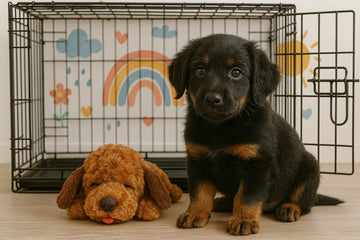Bringing a new puppy home is exciting, but training challenges can sometimes overshadow the joy. Cate training is one of the most important yet challenging aspects of welcoming a new dog into your home. Many pet parents struggle with this crucial step, watching their puppy whine, bark, and resist what should be their safe space. If you're facing similar struggles, a heartbeat toy for dogs is the solution you haven't considered yet.
Why Crate Training Matters?
A properly crate-trained dog gains numerous benefits:
-
Safety and security: A crate gives your dog a den to retreat when feeling overwhelmed.
-
Travel convenience: Dogs familiar with crates are easier to take for vet visits or family trips.
-
Housebreaking assistance: Dogs naturally avoid soiling their sleeping area, making crates valuable tools for potty training.
-
Damage prevention: A secure crate prevents destructive behaviors when you can't supervise your pet.
-
Reduced anxiety: Well-implemented crate training reduces stress in dogs by giving them a predictable safe zone.
When done correctly, crate training isn't a punishment—it's providing your dog with a sanctuary in your home.
Common Struggles New Pet Owners Face While Training
-
Nighttime crying: Puppies often vocalize their distress when left alone at night.
-
Resistance to entry: Some dogs refuse to enter their crate independently.
-
Escape attempts: Determined puppies may try to break out of their crate.
-
Stress behaviors: Excessive drooling, panting, or destructive chewing inside the crate.
-
Regression: Dogs who seemed crate-trained reject the crate after a stressful event.
Dogs are social animals with strong attachment needs—a basic fact many pet owners don't fully appreciate. When puppies are recently separated from their mother and siblings, being alone in a crate can cause real anxiety and distress.
The Role of Heartbeat Toy for Dogs in Crate Training
Reduces Separation Anxiety
The science behind heartbeat toys is surprisingly straightforward. Puppies are accustomed to the constant reassurance of their mother's heartbeat from birth. This rhythmic sound becomes deeply associated with safety, warmth, and security.
This familiar comfort suddenly vanishes when puppies are separated from their mothers and introduced to a new home. The absence of this sound can create significant stress and anxiety.
A heartbeat toy recreates this biological comfort signal. The gentle, rhythmic pulsing mimics a mother dog's heartbeat, triggering an instinctive calming response in puppies. This simple innovation addresses the root cause of many crate training difficulties.
For older dogs with established separation anxiety, the heartbeat provides a consistent, soothing presence that helps reset their nervous system when you're away. The rhythm works similarly to how white noise machines help humans sleep—providing predictable, non-threatening sensory input.
Creates a Calming Environment
Beyond the heartbeat itself, many of these specialized toys incorporate multiple soothing elements:
-
Warmth: Heat packs that mimic the body heat of littermates
-
Familiar scents: Lavender and chamomile infusions that naturally lower canine stress levels
-
Soft textures: Plush materials that invite cuddling and create tactile comfort
This multisensory approach transforms an ordinary crate into a cocoon of comfort. The combination of heartbeat, warmth, and soothing scents creates an environment that speaks directly to your dog's instinctive needs.
Research shows that dogs experiencing this type of sensory comfort show measurable decreases in cortisol (the stress hormone) and increases in oxytocin (the bonding hormone). The result is a calmer, more relaxing puppy who associates their crate with positive feelings.
Encourages Positive Crate Association
The most valuable aspect of using a heartbeat toy for dogs during crate training is how it changes your puppy's perception. Rather than viewing the crate as isolation, they associate it with comfort and security.
This positive association builds faster than traditional crate training methods because it works with your dog's instincts rather than requiring them to override them through training. The heartbeat toy becomes a transitional object—a bridge between their previous security (littermates) and their new life with you.
Over time, this positive association transfers to the crate, making your ongoing training efforts more effective.
How to Use a Heartbeat Toy for Effective Crate Training
Introducing the Toy to Your Puppy
-
Before placing the toy in the crate, let your puppy sniff and interact with it while you're present.
-
Ensure the heartbeat mechanism is turned on and any heat pack is appropriately warmed.
-
Offer treats and praise when your puppy shows interest in the toy.
-
Consider rubbing the toy gently on their blanket to transfer familiar scents.
Some puppies bond immediately with their heartbeat toy, while others may need a gradual introduction. Be patient and never force interaction with the toy.
Placing It in the Crate Properly
-
Position the toy in the back corner of the crate where your puppy sleeps
-
Place it under a thin blanket for muffled heartbeat sounds (mimicking the natural experience)
-
Ensure it remains easily accessible for cuddling
-
Please keep it away from water dishes to prevent damage
The goal is to create a cozy nest-like environment within the crate where your puppy can curl up against the comforting presence of the toy.
Additional Practices for Crate Training Your Puppy
While a heartbeat toy significantly improves crate training success, these additional practices help create a comprehensive approach:
-
Select a large crate for your puppy to stand up, turn around, and lie comfortably.
-
Position the crate in a family area during the day, but consider moving it to a quieter location at night.
-
Reserve particular high-value treats exclusively for crate time.
-
Develop consistent commands like "crate up" or "bedtime" to signal crate entry.
-
Practice brief departures while your puppy is crated, gradually increasing your absence duration.
-
Provide appropriate chew toys alongside the heartbeat toy for mental stimulation.
Remember that consistency is key. The heartbeat toy for dogs available at Calming Buddy provides comfort, but your reliability with feeding, bathroom breaks, and exercise creates the structure your puppy needs to thrive.
Crate training doesn't need to be a battle of wills or endurance test for you or your new puppy. By understanding dogs' natural needs and addressing them with tools like a heartbeat toy, you can transform this challenging process into an opportunity for bonding and growth.



